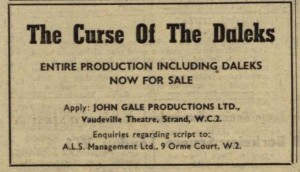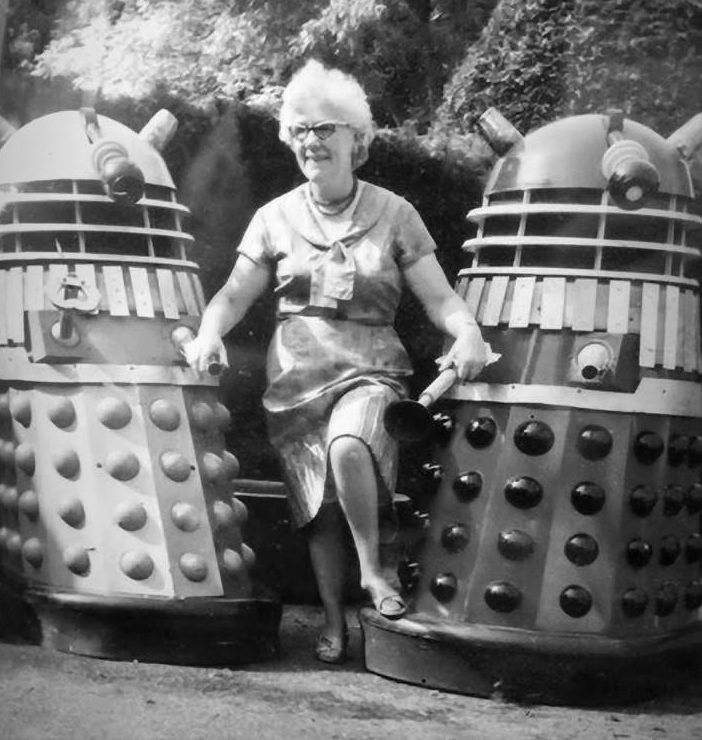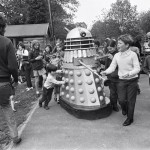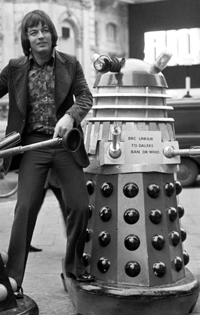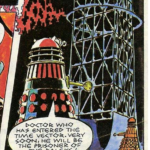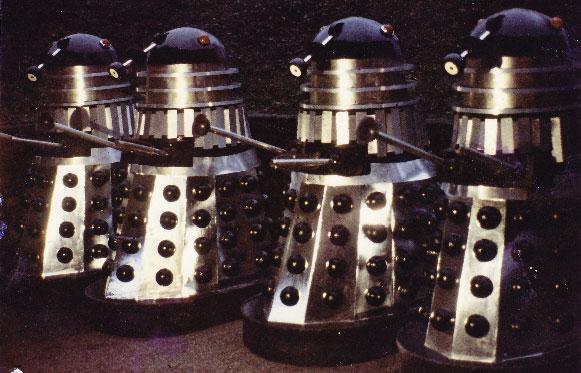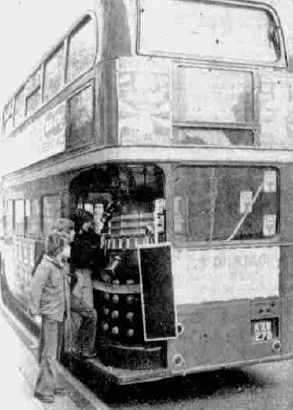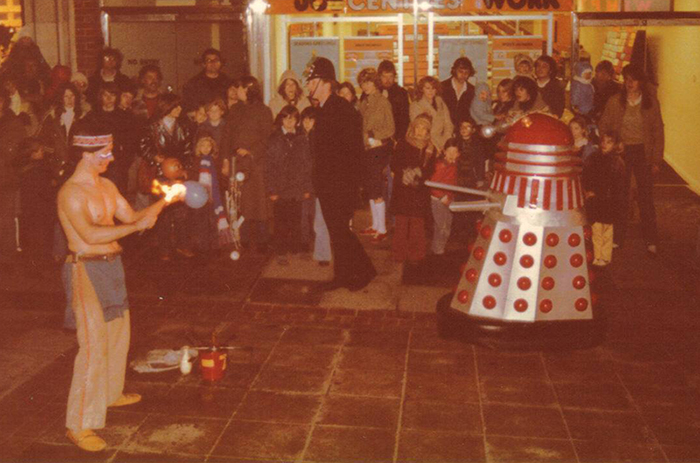A History of the Four Props Kept by Their Creator
Terry’s Daleks
This curious sub-plot begins at the end of 1965 with the announcement of a second film, Daleks Invasion Earth 2150 AD, starring Peter Cushing, in which he would battle the Daleks once again. For this big screen outing, a large collection of Dalek props was assembled, which included the five props built for the stage play Curse of the Daleks. A staggering nineteen Daleks in all were utilised during the making of the film in early 1966. More than twice the total props used in the first Dalek movie. Fourteen of the props were used as hero props with the remaining five being mainly FX props even though the standard of build and articulation was almost equivalent to the main props.
There are several ways of discerning the movie props from each other, the main two methods being to check the placement of the shoulder slats, and the bolts on the front of the skirt. The bolts were used to support the seat inside and, like the slats, were arranged in unique patterns on each skirt.
Just like the TV series versions before it, sections of Daleks would swap around during the making of the film. However for such a large number of props the number of swaps is surprisingly few and generally only occurs between half of the main hero props.
After filming concluded three of the Daleks were given away in a Sugar Puffs competition and, after promotional duties were complete, Terry Nation obtained four for his own use.
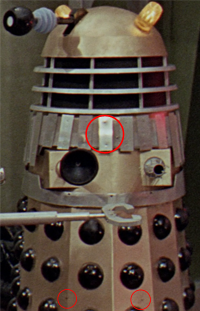
Dalek AARUII 19 with wide spaced slat rivets
His first prop, and the easiest to spot clearly, is Dalek AARUII 19. This prop has wide spaced rivets on its slats and is one of only two Daleks whose “solar panels” were mounted this way. Its skirt has a notable bolt on its left front panel and what appears to be a small hole in the very edge of its right front panel. It was the last of the 19 props to appear onscreen and therefore has the final number.
In the two years since completion of the film, it had been painted into a smart red finish with silver slats and black hemispheres. Flaking paint on the large eyeball showed it had been made from an orange ballcock.

Dalek AARUII 9
Nation’s second Dalek was Dalek AARUII 9. This prop was best known for attempting to shoot the prisoner from the top of the building near the Dalek saucer. The prop did have one change of skirt during the filming but as this was its most prominent scene we refer to its complete form here as Dalek AARUII 9. This Dalek had a series of longer slats between its gun and arm box, one of which overhangs the gun box. No other prop had this feature. Like Dalek AARUII 19 it also had a large eyeball.
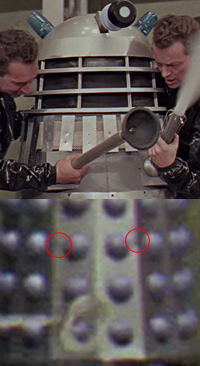
Dalek AARUII 11
The third Dalek was Dalek AARUII 11. Like Dalek AARUII 9, this Dalek wasn’t heavily featured in the film but did have one noticeable scene. During the climax of the film, two Robomen grapple with the Dalek and a close up shot reveals a silvery sheen on the mesh of the neck section. The grappling also bent the rods of the gun quite badly. The prop had a standard sized eyeball.
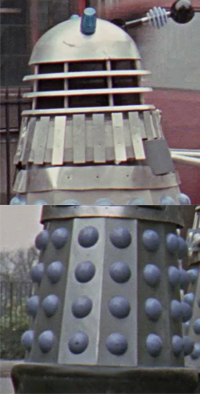
The upper section of Dalek AARUII 14 and the skirt of Dalek AARUII 12
The fourth and final Dalek was perhaps the most interesting as its top half consisted of one of the FX Daleks. During the making of the film, Dalek AARUII 14 had been thrown down the ramp of the Saucer and bashed by the escaping Wyler and Susan in the van and yet was still in a good enough condition to be used again. The scene on the ramp does very little damage to the prop and its clear that when the Dalek is hit by the van its the skirt that takes the vast majority of the impact. The shoulder section is thrown clear and must have landed in such a way as to not cause much damage.
After the film, it was given the skirt of Dalek AARUII 12 which itself had a some prominent moments in the movie. It was used in in the initial battle scenes at the saucer and also appeared in van blockade scene.
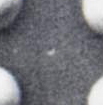
The hole in the ‘Curse’ skirts
We therefore refer to this Dalek as Dalek AARUII 14-12. It was very likely this Dalek had a dome donated from another Dalek which also had the larger style eyeball.
All four skirt sections exhibited holes in the centre of the rear panel. This is something that was unique to the Curse of the Daleks props and therefore suggests these sections were returned to the production after use in the film (and subsequent promotion) and Nation purchased them when they came up for sale in October 1966.
It was around this time that Nation was attempting to get a series off the ground that would be separate from Doctor Who but feature the Daleks and entitled The Destroyers. Letters between the BBC and Nation’s agent, Beryl Vertue, suggest that he attempted to borrow the existing BBC props but it would seem the four movie Daleks were also intended for the production. His scripts of The Destroyers referred to a ‘red Dalek’ and as it happened, one of them had been repainted in red. More about the production can be found in episode five of our video series, Terry Nation Army Series One.
The Whicker Man

Alan Whicker and Terry Nation inspect Dalek AARUII 19
And so in 1968, as part of his ‘Whicker’s World’ series, Alan Whicker paid Terry Nation a visit and thus revealed the four props he owned. The documentary was called A Handful of Horrors: I Don’t Like My Monsters to Have Oedipus Complexes and concerned the horror industry and why we like to be frightened. The shots of the Daleks in the documentary are fleeting, save for the view afforded of Dalek AARUII 19, when Whicker and Nation stop by the prop.
Refurbishments and repainting had taken place, but there were still enough identifying features glimpsed to piece the facts together and confirm the four props that Nation had.
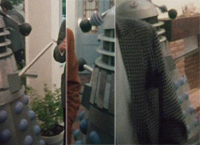
Daleks AARUII 9 (left), Dalek AARUII 11 and Dalek AARUII 14-12
After leaving Dalek AARUII 19 Whicker and Nation make their way past Dalek AARUII 9 and Dalek AARUII 11 and we get a brief look at Dalek AARUII 14-12 as they leave the room. It is clear that despite most of the main bulk of that prop being in good condition, there is one light missing and possibly only one appendage protruding from the front.
This appearance would be the first known public display of Nation’s Daleks. However, ever the entrepreneur and charity supporter, the props would appear many more times during the late 1960s and 1970s, helping to make up for the loss of his unmade Dalek series.

Dalek AARUII 19 in Teynham. Photo – Steve Williams
In fact, just a few months later, in December 1968, Dalek AARUII 19 got its first known ‘charity’ outing when Steve Williams, who used to be Nation’s paperboy, managed to persuade him to loan a prop for a good cause in nearby Teynham.
Steve recalls: “I borrowed a Dalek from him in order to publicise the Church Bazaar that my Mother, Phyllis Williams, organized at the Labour Hall (now known as the Community Hall) to raise funds to restore the roofing at St Mary’s Church. There was nearly a disaster just before the Fair. Shock, horror my Dad, Glynn Williams, managed to break it! Just in time, Teynham’s super hero (me) managed to fix it. I had great fun at the Fair inside the Dalek operating it. The East Kent Gazette gave us good publicity and included a couple of photographs. Terry and his wife actually came down to the hall and did the “glad handing” publicity bits. He was a really nice guy and really cared about Teynham.”
Although Steve doesn’t mention what damage occurred to the prop it would be indicative of the treatment the props would get in the years to come. In fact, this picture (upper left), taken soon after Nation has obtained the Daleks, show that the iris of Dalek AARUII 9 was already missing.
Honey Monsters
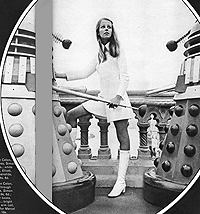
The Daleks on Blackfriars Bridge
The following year, two of the props were in use again, this time for a young women’s magazine called Honey, whose cover proclaimed: “A girl’s best accessory is a man” – but in this instance the accessories were in fact two Daleks.
This April 1969 issue used two of Terry Nation’s props in a fashion article that showed off futuristic white outfits. Photos were taken in several locations including roads near Fleet Street, where the publication was based, and the nearby Blackfriars Bridge.
The more identifiable of the two props is of course Dalek AARUII 19. The colour-scheme alone is distinctive enough, but the photo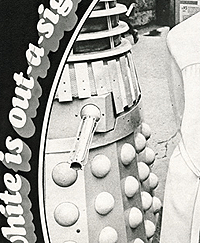 s also show the wide-spaced rivets on the slats and the other identifying features.
s also show the wide-spaced rivets on the slats and the other identifying features.
Third party photographs of the shoot, taking place on the corner of Bouverie Street and Fleet Street, show that during the day the left-hand light is knocked off of Dalek AARUII 19. It is present in magazine photographs but missing in the third party images. The iris also appears and disappears between the two sets of photographs. In addition, the other shots show a slat is hanging off at the rear of the shoulders and that a number were secured by screwing through the centre of the slat and into the collar.
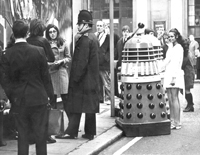
The Daleks in Bouverie Street
The other Dalek present at the shoot gave the first indication of what was to come for the props in that it was the first time two of Nation’s props were mixed. It was a combination of Dalek AARUII 11 and Dalek AARUII 12. Quite remarkably, some three years after the film finished recording, the silvery sheen still remained on the neck. The pictures also give a clear shot of the gun with its rods still looking rather worse for wear.
Festival of the Daleks

Dalek AARUII 9 at the Kingsgate Festival
By the early 1970s, news of the four Daleks in Nation’s possession was starting to spread and the props were getting requests to attend events more regularly. The 1970 to 1971 period was a busy one for the Daleks and one such event they were required for was the Kingsgate Festival at Kilburn Grange Park in London. This was an early incarnation of the Kilburn festival which still runs today and encourages arts and leisure activities.
The prop that attended on the day was the upper section of Dalek AARUII 9 and the skirt of Dalek AARUII 11 – thus becoming the unfortunately-named Dalek AARUII 9-11. With large groups of unsupervised children in the area the prop took some damage! Several of the slats were bent up and twisted and the lower collar had come apart at the front. However, it was clear that the Dalek had sustained damage prior to this appearance outing too. The claw was now missing, the light covers were of a different type and the skirt was showing a patch of damage across two of its front panels.

Dalek AARUII 19 in Lynsted. Photo – Ellen Olney
In August 1971, Nation was asked to attend and open the Lynsted fete in his own village. He took Dalek AARUII 19 with him to the local Vicarage where the event was taking place to boost funds for the church. The prop was largely in the same condition it had been in 1969 although the iris had now disappeared permanently. Children were encouraged to have their pictures taken with the Dalek and rides in the prop itself were also given. With the Dalek owner in residence the prop would be well treated it would seem.
Major Changes and Vanishing Props
Some six years after Nation had obtained the four Daleks they were now starting to show some major damage and needed some refurbishing to keep them going. The upper section of Dalek AARUII 11 (matched with skirt of AARUII 9) received an outing on a visit to Woolhampton Primary School in May 1972 . It was still in reasonable condition with a new set of light covers, however, Dalek AARUII 19 had lost its eyeball completely and the discs were broken or lost.
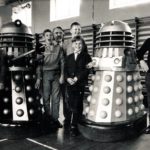
Dalek AARUII 11-9 (left) and Dalek AARUII 14-12 at St. Nicholas School in Redhill. Click for a larger view.
Later in the year, St. Nicholas School in Redhill, Surrey, also managed to obtain two of the props for their fete. Receiving a rare outing was Dalek AARUII 14-12. Only the skirt of this Dalek had been since the Whicker’s World footage. The Dalek was looking a little worse for wear with its eye broken off completely but the appearance did confirm the Dalek had been given one of the Curse of the Daleks ‘spoked’ guns. Also attending was Dalek AARUII 11-9. Unlike its counterpart, this Dalek had had some refurbishment. The whole prop was now painted a smart black and gold although the unusual beaker lights seen at Woolhampton School had also vanished.
It was around this time that Nation was preparing his drafts for Planet of the Daleks and it would appear the he was hatching a plan to possibly generate some extra cash. In the scripts he referred to a Supreme Dalek as having “a gleaming black shell with golden domes.” The sudden appearance of Dalek AARUII 11-9 in the black and gold finish would suggest that it was this Dalek that he hoped to hire to the BBC for use in the story. The scripts also mention that the Supreme Dalek is accompanied by an “aide” from the Council. Could it be he was hoping to hire at least two of his props to the BBC?

Callum Church with his mother and Dalek AARUII 9-19. Photo – Callum Church
Also around the same time, the upper section of Dalek AARUII 9 would be used again. Schoolboy Callum Church’s father knew a “friend of a friend” who knew Terry Nation and he was able to secure the use of a Dalek for Callum’s school’s Autumn Fayre. The prop was stored in the Church household prior to the event and Callum recalled his lack of sleep in a letter to The Guardian Newspaper some years later. The prop by this point was a real mish mash of parts with the silver upper section of Dalek AARUII 9 and the skirt of Dalek AARUII 19 – Dalek AARUII 9-19.
The skirt of Dalek AARUII 19 remained in its red and black finish and the shoulders of Dalek AARUII 9 silver, therefore the whole look was very odd. Considerable damage was also starting to show along the rim of its dome to add to its already missing iris. The neck of the prop had further wear and tear since the Kingsgate Festival and the rings were starting to buckle – the the top one looking particularly bad. Some repairs had been attempted though with two standard car lights pushed onto the end of the bulb housings to replace the missing beakers and a small silver disc replaced the missing claw.
The first major public airing for Nation’s Daleks would be late in 1972 and the props had received some rather odd changes by this time.
In November, Jon Pertwee released a record based upon the Doctor Who theme music. The record was released on the Purple Records label which was owned by rock group Deep Purple. Pertwee was a close friend of Anthony Edwards who co-managed the band itself and was able to arrange the recording very easily. Edwards used his entrepreneurial skills to devise some promotion for the record and hired three of Nation’s Daleks for the event. The record was released on 17th November and the promotion started in earnest in early December. The plan was for the Daleks to picket the BBC and Purple Records offices and call for a ban on the record. The newspapers picked up on the fun idea and ran with it.
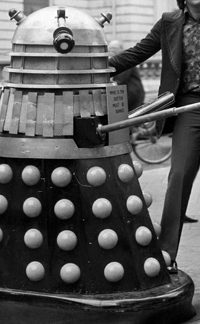
Dalek AARUII 11-12 and Blackburn (cropped)
Radio One disc jockey, Tony Blackburn, was brought in to be pictured with Dalek AARUII 11-12 and Dalek AARUII 14-19 outside of Broadcasting House in London on 4th December and the complete Dalek AARUII 9 was based at the Purple Records offices at 25, Newman Street.
Signs of the odd modifications being carried out at the time were apparent on the props at Broadcasting House. The lights of Dalek AARUII 11 had a similar repair to that of Dalek AARUII 9 in that some standard car lights were placed on the bulb housings. The appendages of Dalek AARUII 14 had been reworked completely. The original spoked gun was now gone so the arm was split into sections with the thinner section remaining in the ‘arm’ side, but with discs slotted along its length and wires joining them up. This gave it a gun like appearance. The outer section was placed in the gun side and extra rods were added to its length. The eyestalk was replaced and had now been modified with a torch. This was a standard domestic torch which was fitted into a large ballcock. It also had new large beaker-style lights fitted.
These Daleks had been repainted too, with the skirt of Dalek AARUII 11-12 now being black with red hemispheres but the top section remained in its black and gold from the repaint prior to the Redhill school visit. The skirt of Dalek AARUII 14-19 was still in its red and black. Its shoulders, slats and neck were now silver and its dome, red.
Over at Newman Street, the state of Dalek AARUII 9 showed it hadn’t been given as much attention. Although in its complete form, the skirt had now been painted into a black finish with gold hemispheres. The pairing of the silver shoulders with the black and gold skirt of Dalek AARUII 9 (last seen at Redhill School and effectively splitting the two halves of Nation’s ‘new’ Supreme Dalek across different Daleks) was an odd site indeed despite it being a correct pairing! There was now clear damage to the top ring of Dalek AARUII 9s neck and the little silver disc on the end of the arm (seen with Callum Church) was missing. Damage to the slats was now extensive and, on the whole, the prop looked rather sorry.

Dalek AARUII 9 at 25 Newman Street in the TV Action report
A mystery surrounds an incident that occurred at the time. A report, dated 5th December, attached to the picture of Dalek AARUII 9 suggests panic ensued when two of the Daleks were stolen from the doorstep of of the Purple Records office in the lunch hour of the 4th. Anthony Edwards was quoted as saying “I can see the funny side of it now, but I nearly passed out at the time. Someone probably thought they had been dumped and took them home for their children.” The post script refers to the picture of the sole remaining Dalek – Dalek AARUII 9. This information was also picked up in issues 101 and 102 of TV Action comic dated, weekending, 20th and 27th January 1973 respectively. The Daleks were still being reported as missing, although the report in issue 101 stated the theft occurred on the 5th December.
However, the modified dome of Dalek AARUII 14-12 with its new torch eye is seen at both Broadcasting House and on Dalek AARUII 9 at Newman Street but without the new large lights. If the two Daleks with Tony Blackburn had been stolen how could the same dome be at both locations? The mystery could be made clearer by recalling the quote from Anthony Edwards. His remark seems a little glib in the circumstances when considering two valuable Daleks had been stolen. The idea that he “can see the funny side of it now” suggests that they perhaps they were only misplaced momentarily. Perhaps someone moved them round a corner out of sight and the whole story was exaggerated to give a bigger story for the papers to report on. Hefty damage may also explain a rather hastily assembled prop at Purple Records to show the news reporter.
Whatever the outcome, it appears as if at least one Dalek did go missing as this would be the last known verifiable appearance of the shoulder section of Dalek AARUII 11 and the skirt of Dalek AARUII 19. This was a setback to Nation’s plans to use one of his Daleks in the, soon to be taped, Planet of the Daleks episodes.
Back On Screen

The ‘new’ Supreme Dalek
1973 was a very important year in Doctor Who’s history. It was its tenth anniversary and Barry Letts planned a twelve-part epic, split over two stories, the second group of six episodes would include the Daleks. More about this can be read on our Planet of the Daleks page.
With Nation having planned to use one of his own props as the Supreme Dalek and half of that having been stolen the previous month, a race was on to provide a replacement. The skirt of Dalek AARUII 9 remained in its black and gold livery and so the upper section of Dalek AARUII 12 was hastily repainted to match.
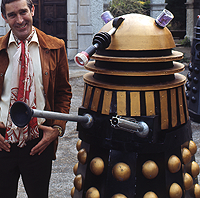
Nation poses for the Radio Times
Changes had taken place to the Dalek in the months since the Lynstead fete. The eyeball had been replaced with a domestic torch in a similar vein to Dalek AAARUII 14s, although this time not fitted into a large eyeball. The torch would light up in combination with the dome lights. The neck rings had been replaced completely with a new type that had a flat edge. A metal strip with spaced studs ran around the edge the the rings and the the neck rods had been removed completely. New lights had also been fitted. Gone were the original beakers and in their place were fitted some jars with a purple film running around the inside. Although some of the original features were now stripped away.
Its likely that the original plan for the prop was to add it to the black and red skirt of Dalek ARRUII 12 that was seen with Tony Blackurn at the BBC as subsequent pictures showing the underside of the new neck rings prove they had been painted red before their ’emergency’ change to gold.
A few months after the completion of taping for Planet of the Daleks, the Radio Times visited Terry Nation at his home for a 10th Anniversary special they were planning. Two of the new ‘Goon’ props built for Planet of the Daleks were brought along for a photocall, but two of Nation’s own Daleks also appeared. Of course, the smart Dalek AARUII 19-9 took pride of place but, lurking in the rear of the shot, was a rather dilapidated Dalek AARUII 9-11.
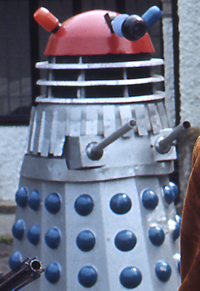
The ‘Red Top’ Dalek
The prop retained its red dome with the damaged rim but some repairs had been carried out though as a new top neck ring replaced the split ring seen at the Purple Records office. The ring that was used did not have the holes through which the neck rods would be threaded and so in order to slot the ring in place, the tops of the rods had be cut off, as this was easier than drilling new slots. The new ring was actually too wide and so the usual decrease in size as they go up the neck was lost and left a very subtle but distinctive appearance.
Perhaps more distinctively, new jar lights had been added that were coloured internally with paint – red in one light and blue in the other. Despite the Dalek’s dishevelled appearance it was still a very striking look and has become commonly known as the ‘Red Top’ Dalek.

The Toy Fair at Chelsea Town Hall. Photo – James Russell
Later that year, November saw the two props appear again at Chelsea Town Hall Toy Fair in aid of Oxfam. A number of TV related characters were in attendance, including the popular magician Jack Devlin. James Russell, son of film maker Ken, was lucky enough to visit the fair and got some great close up pictures of the Daleks. It was clear they had suffered in the short period since the Radio Times shoot. The hemispheres were badly scratched and black paint had been scraped from Dalek AARUII 19-9 revealing some of the red paint underneath. The Dalek operators were given cassette machines so the Daleks could shout favourite phrases to the children!
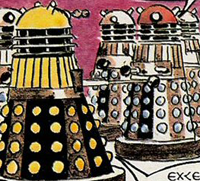
Gerry Haylock’s Dalek artwork in 1972
Intriguingly, were the unusual colours of these Daleks actually influenced by TV Action and Countdown Comic? In 1971, Gerry Haylock was producing the artwork for the Doctor Who comic strip ‘Sub Zero’ which was published in January 1972. He used these exact colours that hadn’t been seen on TV or film at that time. It would appear that Nation had seen the artwork, possibly for approval of the story, and decided to ‘borrow’ them for his most recent TV adventure. Its possible that the reference to an ‘aide’ in the scripts of Planet of the Daleks meant that the ‘Red Top’ was also in his plans to appear onscreen.
Seven Keys to Doomsday
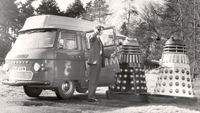
The Supreme and Red Top try to board the Sittingbourne Postbus
As the year turned to 1974, the same two Daleks appeared in an unusual collaboration in March when they were photographed trying to board the Sittingbourne Postbus. The idea was to promote the local Postbus service in the largely rural Sittingbourne area where a more normal bus service was regarded as uneconomic.

Marc Sinclair at Terry Nation’s home. Photo – Marc Sinclair
Later, in the summer, one lucky fan, Marc Sinclair, who lived locally to Terry Nation, was given a treat when he was invited to tea with his family and Matron from his school at the Nation home in Lynsted. Although Nation was away on business, Marc recalls having tea with his wife Kate and meeting Dalek AARUII 19-9 and Dalek AARUII 9-11. Both were kept in an outhouse in a walled off part of the garden and both were starting to look well worn. Marc was able to play with the Daleks all afternoon and remembers the lights on Dalek AARUII 19-9 were still working.
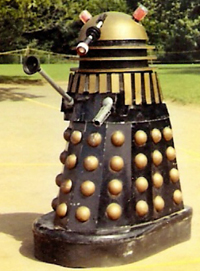
At Parkwood School in 1974
A short time later, on Saturday 6th July, Dalek AARUII 19-9 visited Parkwood School in Rainham, Kent1. The Dalek firstly took park in a parade around Rainham in the early afternoon before making its way to the school where Nation was on hand to open the school’s fete. Doctor Who researcher, Richard Bignell, was at the event and although, sadly, he didn’t get to meet Nation he does recall there being photo opportunities to be had with the Dalek.
Just shy of two months later, Nation was the guest at another local fete. This time it was the 21st annual Pembury Hospital Family Fete taking place on Saturday 31st August. Nation’s own son, Joe, had been born at the hospital 15 months prior and his speech praised the staff for their caring and efficiency.
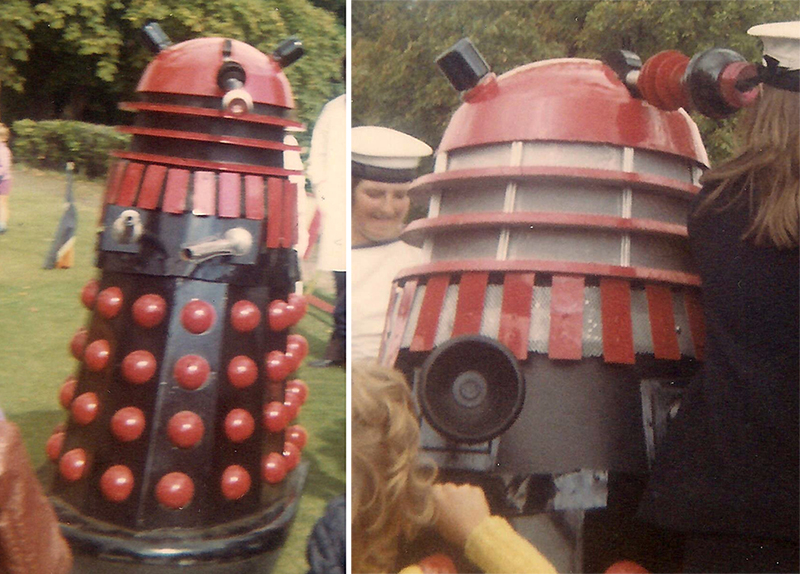
Dalek AARUII 19-9 (left) and Dalek AARUII 14-12 at Pembury Hospital with Terry Nation. Photos – Martin Lane. Click for a larger view.
He took with him two of his Dalek props which had been paraded around the town on a truck the previous day to promote the fete. One of the Daleks was Dalek AARUII 19-9. Since its appearance at Parkwood school it had been given some refurbishment. Its black paint had been touched up and the hemispheres, slats and dome had all now been painted red. New dark jars had also been added as lights. Unfortunately, the sucker on the arm was now missing.
The other prop provided saw Dalek AARUII 14-12 recombined – just as Nation had received it several years before. The skirt still retained its black and red scheme and the dome and eye were still the same as its appearance at Broadcasting House with Tony Blackburn. It was also fitted with the same dark jars that Dalek AARUII 19-9 had.
However, the shoulder section had been given a major overhaul. The whole top collar and slats had been remounted in a higher position with some of the slats now distorted slightly to fit them into place. Two new plates had been added to the front of the gun and arm box and further changes had been made to the gun and arm themselves. They had now switched sides again and a jar had been added on the end of the thinner section on the gun side. The main body was painted black and the slats red, to complete the colour scheme.
It would appear that Gerry Haylock had again influenced Nation in his choices of these colours. TV Action’s 1972 story ‘Planet of the Daleks’ had featured a black and red Dalek unlike anything that had appeared on TV at that time.
Record crowds attended the event and nearly £2500 was raised that would go towards building a shop in the grounds of the hospital.
In early November of 1974 promotion began for the second Doctor Who stage play Seven Keys to Doomsday which was due to begin in mid-December. Scripted by Terrance Dicks, the play was originally due to star Jon Pertwee but the role eventually went to Trevor Martin who was pictured with two of Nation’s Daleks outside of the Adelphi Theatre on The Strand in two separate photocall sessions.
The production company took the chance to hire the Daleks for two purposes. Firstly to promote the play before the production’s own props were ready and secondly to take designs cues from. Just a few weeks since their appearance at Pembury Hospital, Dalek AARUII 19-9 and Dalek AARUII 14-12 were together for the cameras again.
Allister Bowtell, who worked on the TV series of Doctor Who, oversaw the construction of the five Dalek props used in the play and they had elements taken directly from Dalek AARUII 19-9. The fender was of the larger ‘Movie Dalek’ style but more importantly the neck rings were flat edged and there were no neck rods. The slats also had the wide spaced rivets that were unique to Dalek AARUII 19 and Dalek AARUII 12.
To further promote the play, Dalek AARUII 14-12 was placed on a bus, along with a sound system, and driven around the streets of London. The unusual sight attracted the attention of children and local newspaper reporters.
Breakfast with the Daleks

Nation and his daughter, Rebecca
The TV serial, Genesis of the Daleks, in 1975 would be the last Dalek serial on TV for four years and this coupled with the fact that the BBC began its own more organised scheme for hiring out Dalek props around this time meant that appearances for the ‘Nation Daleks’ would get fewer and further between in the upcoming years.
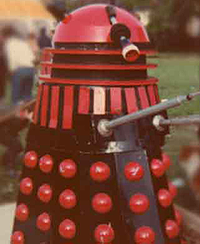
Dalek AARUII 19-12 at the BBC Roadshow. Photo – George Farrell
Nation started concentrating on his children’s novel Rebecca’s World, named after his own daughter, but he never missed the opportunity to include his Daleks, even when the subject was not Doctor Who related. To promote the launch of the book, he had himself pictured with his daughter and a Dalek. With two Daleks now given a red and black colour scheme it was easy to mix sections up and so Dalek AARUII 19 was matched with the skirt of Dalek AARUII 12 and photographed in Nation’s garden in August.
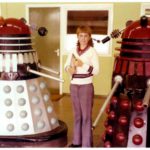
Dalek AARUII 9-11 (left) and Dalek AARUII 19-9 with Ian Scales. Picture – Ian Scales. Click for a larger view.
The same summer, the same Dalek (now missing one light) appeared at a BBC Roadshow. The Dalek was brought in on the back of a van and new Doctor, Tom Baker, and a Cyberman also made an appearance.
In October 1976, Nation made a personal appearance at Swale Motors in Sittingbourne where he signed books and merchandise for the many visitors that flocked to see him. He was giving away prizes as part of a joint competition with local paper and the car dealer.
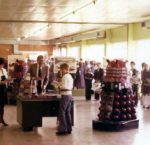
Dalek AARUII 14-12 (right) now missing its eye and gun. Picture – Ian Scales. Click for a larger view.
He took with him three of his Daleks – Dalek AARUII 19 which was again matched with the skirt of Dalek AARUII 9 (Dalek AARUII 19-9). The eyestalk was now missing the end of the torch section.
Sporting a new black shoulder section and a new iris for its eye was ‘The Red Top’ – Dalek AARUII 9-11. The third Dalek at the showroom was a rare outing for Dalek AARUII 14-12 which had last been seen outside the Adelphi in 1974. The prop was now missing its eyestalk and makeshift gun that it had been seen with at the theatre.
This was the last verifiable appearance for the shoulders of Dalek AARUII 14 and the skirt of Dalek AARUII 11.

Promoting Weetabix
A year later the Weetabix company were looking to promote their second Doctor Who card and game series and decided a TV advert would be perfect. Dalek AARUII 19-12 was hired from Nation and again given a spruce up for this TV appearance. The paintwork was retouched and its torch eye was replaced with an older style ballcock, and it was given some smaller, clear lights. A new red sucker replaced the missing rubber one. Ironically, just as in the 1975 Weetabix promotion, both the ‘Red Top’ and gold ‘Supreme’ Dalek appeared on the stand-up cards included in the packets.

Selfridges window display in December 1977
In December of 1977, Selfridges, on Oxford Street, wanted to promote their big Christmas Toy Fair. Lots of TV related brands would be included including The Muppets and of course, Doctor Who. A window section would be given over to a Doctor Who themed display and included a TARDIS prop, a faceless Zygon and a Tom Baker mannequin. A Dalek, hired from Nation, completed the display and again it was Dalek AARUII 19-12 that was used. Movietone were on hand to make a film of the entire toy fair and its displays. There are unsubstantiated reports that all four Daleks were hired and one or more were stolen as the props were being unloaded from the van. As only two complete props are known to have been seen after this time it could be that the story is true.
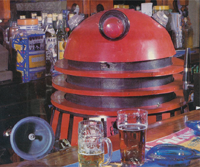
The ‘Supreme’ exterminates drunk drivers. Photo supplied by – Mick Hall
Some changes had occurred again to the Dalek in the short time since the Weetabix promotion. It now had a proper rubber sucker again and the arm and gun had been painted black. This would be the last verifiable appearance for the skirt section of Dalek AARUII 12.
The following year the upper section of Dalek AARUII 19 made a rather unusual appearance as part of a Police calendar. The prop was placed behind the bar of public house and it suggested that drunk drivers should be ‘exterminated’. The ballcock eye had a new red light fitting attached to it.
Up For Grabs
Terry Nation moved to the USA in 1980 to pursue his career opportunities and stories abound as to what happened to his four Dalek props. One was possibly given to a friend of his and one or more donated to a local children’s hospice. As mentioned, there is also the possibility that one or more were stolen from Purple Records and in 1977, from outside Selfridges. 40 plus years after their last verifiable appearances, it is impossible to say accurately what happened to the four Daleks.
At least one further organised event including Nation’s Daleks took place in Ashford in Kent on 10th December 1980 – the annual Children’s day. The pre-Christmas day saw lots of activities in the High Street and included two Daleks gliding around. Dalek AARUII 19-9 was one of the Daleks included and was now sporting a smart silver and red livery – another not seen on TV or on film before. Its safe to assume, that at least until December 1980, the estate of Terry Nation in England was still in control of the remaining props.
Whatever was floating around during the later 1980s and 90s at the Children’s hospice, only one prop seemed to emerge when the place closed in 19952. A year later, a Dalek came up for auction at Phillips on 16th June 1996 and, for the first time in many years, both sections of Dalek AARUII 9 were reunited. After years of swapping sections, Dalek AARUII 9 was back together and ready to shoot prisoners from roof-tops again!

Mick Hall’s Dalek AARUII 9. Photo – Mick Hall
The Dalek was sold to a collector in Blackpool and considering its years of use it was in remarkable condition. At this time it was mainly silver with red hemispheres and slats. The damaged rim dome was also still red from its time in the 1970s although it now had the ballcock eyeball last seen on Dalek AARUII 19 in 1980. In 2000 it was sold on to Mick Hall, a collector who has many Dalek movie related items, and it is one of his most cherished items.
And so ends the tale of Terry Nation’s Daleks. Four props which were muddled, rehashed and repainted over many decades. One survives out there… do any more?
-
Thanks to Richard Bignell for the information regarding Parkwood School
-
Thanks to J. Wrigley for information from John Peel
